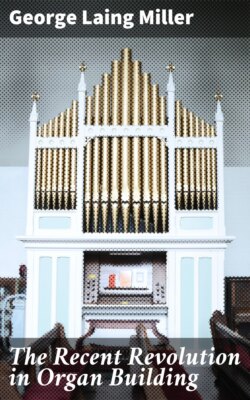Читать книгу The Recent Revolution in Organ Building - George Laing Miller - Страница 10
На сайте Литреса книга снята с продажи.
THE ORGAN IN THE NINETEENTH CENTURY.
ОглавлениеTable of Contents
Before proceeding further we propose to give a brief description of the construction of the organ at the beginning of the last century and explain the technical terms we shall use later.
As everybody knows, the tone comes from the pipes, some of which are to be seen in the front of the instrument. The pipes are of various shapes and sizes and are arranged in ranks or rows upon the wind-chest. Each of these ranks is called a stop or register. It should be borne in mind that this word stop refers to the row of pipes, and not to the stop-knobs by the keyboard which operate the mechanism bringing the row of pipes into play. Much confusion of ideas prevails on this point, and cheap builders used to take advantage of it by providing two stop-knobs for each row of pipes, thereby making their instruments appear to contain more pipes than were actually there. This practice was at one time very prevalent in the United States.
The early organ-builders to obtain variety of tone divided the pipes into groups placed in various positions, each playable from a separate keyboard, and this practice prevails to this day. An average church organ will contain three or four wind-chests, each with its quota of pipes and designated as follows:
1. The Great organ, consisting of the front pipes and other loud-speaking stops. Back of this and usually elevated above the level of the Great organ pipes is
2. The Swell organ, all the pipes of which are contained in a wooden box with Venetian shutters in front, the opening or closing of which modifies the tone; below the Swell box is placed
3. The Choir organ, containing soft speaking pipes suitable for accompanying the human voice; and back of all or on the sides is
4. The Pedal organ, containing the large pipes played by the pedals.
Larger instruments have still another wind-chest called the Solo organ, the pipes of which are very loud and are usually placed high above the Great organ.
In some large English organs, notably that in the Town Hall of Leeds, a further division was effected, the pipes of the Great organ being placed on two wind-chests, one behind the other. They were known as Front Great and Back Great.
The original reason for dividing a church organ in this manner seems to have been the impossibility of supplying a large number of stops with wind from a single wind-chest.
It will thus be seen that our average church organ is really made up of three or four smaller organs combined.
The wind-chest is an oblong box supplied with air under pressure from the bellows and containing the valves (called pallets) controlling the access of the wind to the pipes. Between the pallet and the foot of the pipe comes another valve called the slider, which controls the access of the wind to the whole row of pipes or stop. The pallet is operated from the keyboard by the key action. Every key on the keyboard has a corresponding pallet in the wind-chest, and every stop-knob operates a slider under the pipes, so that both a slider must be drawn and a pallet depressed before any sound can be got from the pipes. The drawings will make this plain.
Fig. 1 is a front view and Fig. 2 a side view of the wind-chest. A is the wind-chest into which compressed atmospheric air has been introduced, either through the side or bottom, from the end of the wind-trunk B. The pallets, C C C, are held against the openings, D D D, leading from the wind-chest to the mouth of the pipes, by springs underneath them.
